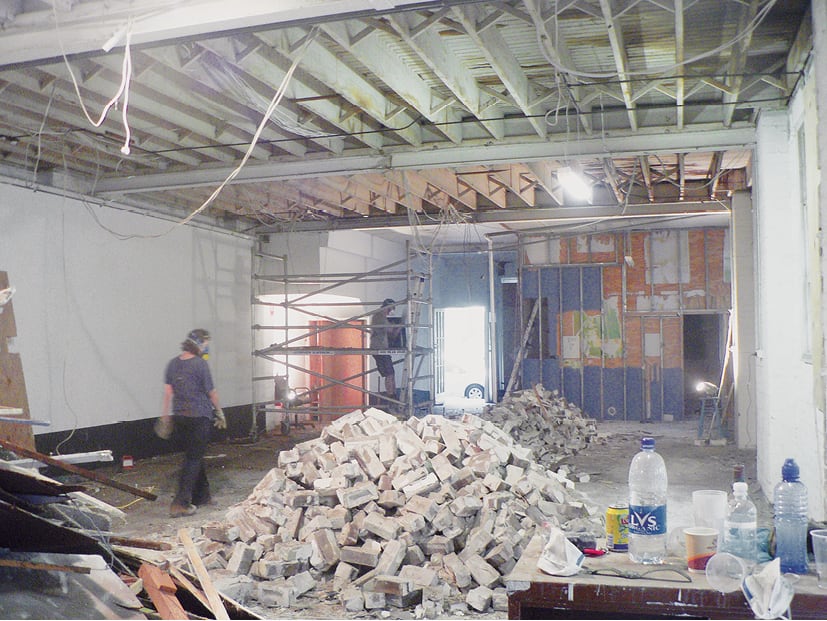
It has become apparent that Artist-Run Initiatives (ARIs) in New South Wales are trying to exist in a climate where both state and local government are publicly pushing to increase the profile of their community and volunteer generated activity. Working in opposition to this, however, is pressure stemming from local government in the form of compliance legislation. For ARIs, a significant part of maintaining an artist-run space appears to be continually assessed through the organisation’s ability to adapt in both creative and bureaucratic channels.
At the Artspace conference, One Way or Another: Artist Self-Organisation in New South Wales held in November 2009, Penelope Benton (co-founder of The Red Rattler, Marrickville) outlined the strenuous difficulties in achieving a best practice model for a compliant not-for-profit volunteer arts organisation. Essential dialogue continued to generate at the Sydney Arts Management Advisory Group (SAMAG) Making Space for Creative Communites seminar in February 2010, where Benton, Marcus Westbury (Renew Newcastle) and Tugi Balog (May Lane Art Project) discussed different approaches used to reinvigorate urban areas through the provision of accessible and affordable spaces for artists and ARIs.
In the time between these two forums, Firstdraft, Sydney’s longest-running ARI with close to a twenty-five year history, was undergoing an extensive renovation after the council issued a Fire Safety Order on its leased premises. A Fire Safety Order, issued in accordance with the requirements of the Environmental Planning and Assessment Act 1979, directs the building owner to undertake specific fire safety improvement works to the property. For Firstdraft, this meant significant modification to the exhibition spaces in response to the compulsory new fire compliant stairwell, while also making extensive changes to widen egress, install an accessible bathroom, build an entrance ramp and install ‘back to base’ fire detection equipment.
As a result of the growing gentrification of areas of inner-Sydney, urban boroughs previously rich with creative enterprises have seen a steady sweep of building assessment under local councils. While not all ARIs choose to operate a permanent exhibition or performance space, those that do, will (if not already) fall subject to the regulations of new environmental and urban planning.
Firstdraft has been providing exhibition spaces and facilitating artistic programs from its Chalmers Street site for close to sixteen years. In order to meet compliance law, an arduous period of redevelopment was undertaken to allow the organisation to continue its creative endeavours in a legal space. While ARIs, including Firstdraft, are synonymous with DIY culture, adherence to legislative compliance law requires specialist consultancy and demands an extensive financial commitment to negotiate strict building code and planning requirements. It is a murky area and more often than not in such circumstances the organisation’s volunteers bear the brunt, drawing upon their own time and resources.
In October 2009, with trepidation and due to a lack of funds, the 2009–10 Board of Directors commenced the demolition of the gallery space themselves. The message ‘Just you wait’ was painted haphazardly across the boarded-up windows throughout the gallery’s six-month closure. For ARIs wishing to sustain an existing space and become regulation compliant, there appears to be a lack of funding opportunities and a lack of willingness from local or state governments to offer in-kind support or even subsidise planning and consultancy fees. Currently, ArtsNSW has capital infrastructure grants available to arts organisations, however funding is not available to upgrade facilities to statutory standards or for the costs of planning or consultancy. The absence of support in these areas will continue to significantly impact the longevity of ARIs and other grass-roots organisations that work within publicly accessible spaces, particularly those who occupy spaces in inner-city areas.
For ARIs and small artist-run organisations, the difficulties in achieving compliance are endemic if the space occupied is leased from a third-party owner. As this is typically the case for ARIs, both government and funding bodies are disinclined to contribute funds. In order for Firstdraft to comply, a capital appeal was launched and months of arduous fundraising were coupled with dedicated volunteer time and labour to raise the funds and undertake the build. For ARIs, particularly those that receive program funding, there is an ongoing need to deliver a quantifiable creative output, whilst also diligently adhering to rigid bureaucratic frameworks. If ARIs are trying to achieve compliance in privately or commercially owned buildings, the overarching renovation costs are likely to be incurred by the landlords initially, with an eventual trickle-down via rent increase to the tenants — most of which have already invested large sums into their space.
There appears to be a significant deficiency of support for ARIs that desire a stationary or permanent space in which to operate. Advisory information and assistance is becoming more readily available through directories such as Empty Spaces (ArtsNSW), but these tend to cater for the set-up of temporary or short-term occupations of space. Recent initiatives, such as Renew Newcastle and City of Sydney’s Accommodation Grant Program, have been successful in encouraging and supporting the use of transient spaces in metropolitan areas. As a result, an ongoing series of temporal creative projects has been given access to space for a brief period of time in unused commercial or council owned buildings.
While these initiatives display an awareness and encourage artistic communities to be more active in urban spaces, they do not offer assistance towards sustaining existing ARIs and other active creative communities, or to ensure their maintenance and longevity. A cooperative and participatory approach between local and state government and arts funding bodies is needed in order to offer ARIs greater assistance with compliance. It will mean that ARIs can invest more time and creative output into their artistic projects, whilst occupying a legal venue. Inevitably, this assistance will allow existing organisations ongoing viability — not only in the ARI sector, but also in the local community where they operate.
Kate Scardifield is a practicing artist based in Sydney and a member of the 2009–10 Firstdraft Board of Directors.
